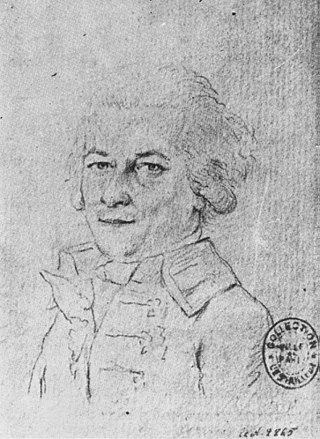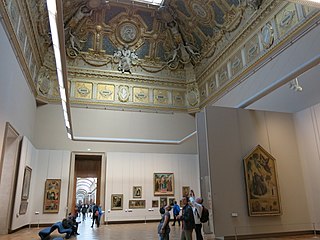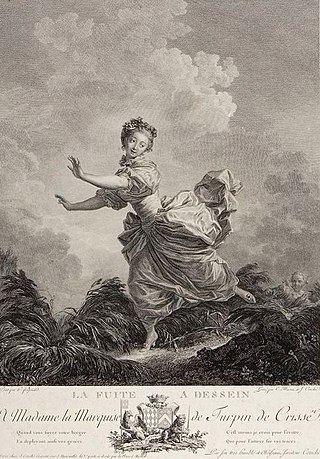

Gabriel de Saint-Aubin, also Gabriel Jacques de Saint-Aubin, (Paris, 14 April 1724 - Paris, 14 February 1780) was a French draftsman, printmaker, etcher and painter.


Gabriel de Saint-Aubin, also Gabriel Jacques de Saint-Aubin, (Paris, 14 April 1724 - Paris, 14 February 1780) was a French draftsman, printmaker, etcher and painter.

His brothers Charles Germain de Saint Aubin and Augustin de Saint-Aubin were also artists, as was his niece, Marie-Françoise, daughter of Charles. [1] He was a student of Étienne Jeaurat and Hyacinthe Collin de Vermont. After three failures to win a Prix de Rome from 1752 to 1754, he left the Académie des Beaux-Arts and joined the Guild of Saint Luke.
A distinctive aspect of Saint-Aubin's art is its inordinate fondness for observation of society on the streets of the capital, which he sketched scenes or entertainment in his wanderings. As such, his engravings etchings and large watercolors are a valuable record of the Parisian artistic life in the eighteenth century. Gallery


François Boucher was a French painter, draughtsman and etcher, who worked in the Rococo style. Boucher is known for his idyllic and voluptuous paintings on classical themes, decorative allegories, and pastoral scenes. He was perhaps the most celebrated painter and decorative artist of the 18th century.

Blois is a commune and the capital city of Loir-et-Cher department, in Centre-Val de Loire, France, on the banks of the lower Loire river between Orléans and Tours.

Jacques Albin Simon Collin de Plancy was a French occultist, demonologist and writer. He published several works on occultism and demonology.

Jean-Honoré Fragonard was a French painter and printmaker whose late Rococo manner was distinguished by remarkable facility, exuberance, and hedonism. One of the most prolific artists active in the last decades of the Ancien Régime, Fragonard produced more than 550 paintings, of which only five are dated. Among his most popular works are genre paintings conveying an atmosphere of intimacy and veiled eroticism.

Ange-Jacques Gabriel was the principal architect of King Louis XV of France. His major works included the Place de la Concorde, the École Militaire, and the Petit Trianon and opera theater at the Palace of Versailles. His style was a careful balance between French Baroque architecture and French neoclassicism.

Jacques-François Blondel was an 18th-century French architect and teacher. After running his own highly successful school of architecture for many years, he was appointed Professor of Architecture at the Académie Royale d'Architecture in 1762, and his Cours d'architecture largely superseded a similarly titled book published in 1675 by his famous namesake, François Blondel, who had occupied the same post in the late 17th century.

The Château d'Anet is a château near Dreux, in the Eure-et-Loir department in northern France, built by Philibert de l'Orme from 1547 to 1552 for Diane de Poitiers, the mistress of Henry II of France. It was built on the former château at the center of the domains of Diane's deceased husband, Louis de Brézé, seigneur d'Anet, Marshal of Normandy and Master of the Hunt.

Charles Germain de Saint Aubin was a French draftsman and embroidery designer to King Louis XV. Published a classic reference on embroidery, L'Art du Brodeur in 1770. In addition to his embroidery designs, he was known for his drawings and engravings.

Marie-Denise Villers was a French painter who specialized in portraits.

Jacques Gabriel was a French architect, the father of the famous Ange-Jacques Gabriel. Jacques Gabriel was a designer, painter and architect of the 17th and 18th centuries and one of the most prominent designers of the Palace of Versailles in his lifetime. For his unique creativity and selflessness, he was always attended by Louis XIV and eventually became a trusted advisor to the monarch. He made important contributions to him during his years of service of which the construction of the Palace of Versailles was the most important.

Joseph-Siffred Duplessis was a French painter known for the clarity and immediacy of his portraits.

Martin Carlin was a Parisian ébéniste (cabinet-maker), born at Freiburg, who was received as Master Ébéniste at Paris on 30 July 1766. Renowned for his "graceful furniture mounted with Sèvres porcelain", Carlin fed into the luxury market of eighteenth-century decorative arts, where porcelain-fitted furniture was considered among "the most exquisite furnishings" within the transitional and neoclassical styles. Carlin's furniture was popular amongst the main great dealers, including Poirier, Daguerre, and Darnault, who sold his furniture to Marie Antoinette and many amongst the social elite class. He died on 6 March 1785.

The Salon Carré is an iconic room of the Louvre Palace, created in its current dimensions during a reconstruction of that part of the palace following a fire in February 1661. It gave its name to the longstanding tradition of Salon exhibitions of contemporary art in Paris which had its heyday there between 1725 and 1848. Since 1849, it has been permanently used by the Louvre Museum, which currently uses it to display Italian Renaissance painting.

Louise Françoise, Duchess of Bourbon was the eldest surviving legitimised daughter of Louis XIV of France and his maîtresse-en-titre Françoise-Athénaïs, Marquise de Montespan. She was said to have been named after her godmother, Louise de La Vallière, the woman her mother had replaced as the king's mistress. Before her marriage, she was known at court as Mademoiselle de Nantes.

St Francis Xavier Church is a parish Roman Catholic church in the 7th arrondissement of Paris dedicated to Francis Xavier, the patron saint of missions. Built in the late 19th century, It gave its name to the nearby Metro station Saint-François-Xavier. It contains the tomb of Madeleine Sophie Barat, a French saint of the Catholic Church and founder of the Society of the Sacred Heart, a worldwide religious institute of educators. It is also known for its collection of Italian Baroque and Mannerist paintings, including a work by Tintoretto. The church was inscribed as an historic monument in 2018.

Gabriel Huquier (1695–1772) was an entrepreneurial French drawer (artist), engraver, printmaker, publisher, and art collector, who became a pivotal figure in the production of French 18th-century ornamental etchings and engravings

Augustin de Saint-Aubin sometimes styled Auguste de Saint-Aubin, belongs to an important dynasty of French designers and engravers.
Marie-Françoise de Saint-Aubin (1753–1822) was a French artist.

Charles-François-Adrien Macret was a French designer and engraver. His works were signed, variously, as Macret, Carolus Macret, C. Macret and C.F. Macret.